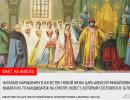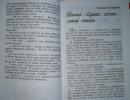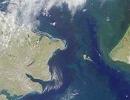Kostya Kravchuk biography. Pioneer heroes of the Great Patriotic War. Pioneer heroes of the Great Patriotic War
...And Kiev resident Kostya Kravchuk was only ten years old. Today, we try not to let children of this age go out alone in the evening, and this is quite understandable and justified. And in...
...And Kiev resident Kostya Kravchuk was only ten years old. Today, we try not to let children of this age go out alone in the evening, and this is quite understandable and justified. And at school, third-graders are not assigned truly responsible tasks, because they are still small. And then, back in 1941, Soviet soldiers entrusted this boy with a shrine - two battle flags.
This happened on September 19 in Kyiv, which was occupied by the Germans that day. There were heavy, bloody battles. Our soldiers were retreating. And Kostya, on the sly from his mother (he lived with her alone, his father died before the war) slipped away from the basement where the women and children were hiding. It was not idle curiosity that drove the boy out into the street. I thought I could at least do something to help the Red Army. And I came across two wounded soldiers. Kostya offered them his help and a home. But the soldiers refused - apparently, they did not want to expose the family to even greater danger. Or their wounds were so severe that it was impossible to do without medical care. The soldiers asked the boy for help from another: to save two red banners.
Did they themselves believe at that moment that the precious relic was in good hands? I think yes. And because war is no time for games even for little people. And because children are capable of great, and sometimes enormous, deeds - without pathos, sincerely, believing to the last in a way that adults often cannot.
So, the banners ended up with Kostya. They had to find a suitable place where the enemies could not reach. The boy buried the relic in the garden near his house. Managed. If he had been ten minutes late, he would have died. Because German boots were already knocking near their house. True, the Nazis did not enter the house itself, they only knocked out several windows.
On the very first day of the occupation, it became clear: a more reliable place was needed. The Germans frightened people as best they could. If a column of prisoners was being led through the city, then, seeing that people were gathering around, the fascists shot those lagging behind or simply snatched someone from the column and bayoneted them. They were not allowed to remove the dead - it was a brutal demonstration of strength and power. The tortured Red Army soldiers lay like that along the road.
Every day they carried out searches in different houses. And Kostya, who did not say a word about the banners even to his mother, was afraid that the Germans would notice a loose bud in the garden and guess everything. In addition, it would soon begin to rain - the fabric would then deteriorate. And so at night the boy dug up the banners, put them in a canvas bag, and tarred it. The next day, he hid it in an abandoned well, which was so unsightly in appearance that it was impossible to even think that anything could be hidden there at all. And how did you get to this well? The streets were patrolled around the clock. If they detain you at night, don't expect mercy. This means that you only need to hide during the day. Kostya took the cow out, clutched some sticks under his armpit, hung the bag over his shoulder - and drove the cow to the distant forest, on the way to which, on the very outskirts, there was a well.
On the way, he kept meeting fascists. But it never occurred to any of them that a simple shepherd was carrying a precious shrine. That this inconspicuous boy is also helping the Red Army. He helps as best he can, as needed at this moment. And if necessary, he will give his life for two banners.
Rarely, but regularly, the boy checked whether the banners were in place. Everything was OK. But one day (this was already in 1943) Kostya did not have time to return home before the curfew - however, just a little. The police grabbed the boy and searched him. Nothing was found. Apparently, Kostya looked so “unsuspicious” that they didn’t even question him. They decided to “bestow great mercy” - to send him to Germany. Together with the rest of the children they were forced into a train. Imagine: Kostina’s mother didn’t know this. She looked for her son around the city, went to the German commandant’s office, but never found out anything. And there, on the train, a boy was tormented by the unknown. He imagined his mother - unhappy, frightened, heartbroken - and his heart grew cold. Then our imagination pictured our Victory. Two rifle regiment- 968th and 970th - enter Kyiv. They don’t have banners, but what would they do without that? And the banners lie very close, in the well. They lie - and will lie for many, many more years, so desperately needed. And no one will know that Kostya fulfilled the fighters’ request...
When approaching one of the stations, when the train slowed down, the boy somehow broke the board and jumped out. The echelon has already left far from Kyiv. And the ten-year-old boy went back along the tracks.
And he came! What did he eat on the way, how could he remain intact?..
Kostya returned home after his hometown was cleared of the enemy. And as soon as he saw his mother, who was dumbfounded and withered from grief, he led her to the well. He explained everything along the way. Together they pulled out the banners of the 968th and 970th Infantry Regiments of the 255th Infantry Division, and together they brought them to our soldiers.

An order is awarded for saving the battle flag. It's fair and just. So an award document was drawn up for the young hero, and on June 1, 1944, a Decree of the Presidium of the Supreme Soviet of the USSR was signed on awarding Konstantin Kononovich Kravchuk the Order of the Red Banner.
This was the first Order of Bones. And the second - already the Red Banner of Labor, appeared after the war, when Konstantin Kononovich (by the way, graduated from the Suvorov School) worked at the Arsenal plant.
Kyiv became one of the first targets of German bombers on June 22. “Kyiv was bombed, they announced to us that war had begun”... Kyiv became the site of one of the largest defeats of the Red Army in 1941: the Southwestern Front, which defended the city, was defeated. The front commander, Colonel General M.P. Kirponos, and the front chief of staff, Major General V.I. Tupikov, died in battle on September 20, along with many other front command officers.
A day later, the head of the Special Department of the Front, State Security Commissioner of the 3rd Rank A.N. Mikheev, also died in battle. In total, the irretrievable losses of the Red Army in the Kyiv defensive operation amounted to 627.8 thousand people.
The Germans entered the mother of Russian cities on September 19. It was on this day that fate crossed the path of Kostya Kravchuk with a group of wounded Red Army soldiers, who, having no illusions about their future, handed over two battle flags to him for safekeeping.
At first, Kostya simply buried a bundle with banners in the garden, but the situation in captured Kyiv was not calm, and there was no reason to expect a quick return. The Germans imposed a new order harshly: Kyiv Jews almost immediately moved in an organized manner to Babi Yar, columns of prisoners stretched through the city, behind which remained the corpses of exhausted Red Army soldiers mercilessly shot by guards. Kostya decided to hide the banners more reliably - and away from his house: he packed the banners in a canvas bag, carefully tarred it and hid it in an abandoned well.

Killed prisoners of war on a Kyiv street. Photographer of the 637th Propaganda Company of the 6th Army of the Wehrmacht, Johannes Hale, took this photo on October 1, 1941.



Keeping a secret—even from my mother—must have been very difficult. Especially considering that Kostya was left without a father early on: he died before the war. However, until the liberation of Kyiv, no one learned about the banners.
Kostya periodically went to the well and checked if his treasure was still there. Once, already in 1943, he was unlucky: he was caught in a raid and was suddenly packed onto a train transporting Ukrainian youth to Germany. He was lucky to escape from the train, but he reached his native Obolonskaya Street after Kyiv was liberated by the Red Army.
And then, after a joyful meeting with his mother, he took the banners of the 968th and 970th rifle regiments to the military commandant’s office.
Presumably, some time was spent checking the circumstances: it’s not every day that a bundle with military relics lands on the commandant’s desk. But on May 23, 1944, award documents were drawn up for Kostya: for saving the Battle Banner in the Soviet Union, he was awarded an order. On May 31, Kostya Kravchuk was reported to Stalin, and on June 1, a Decree of the Presidium of the Supreme Soviet of the USSR was signed awarding Konstantin Kononovich Kravchuk, born in 1931, with the Order of the Red Banner.
There is scanty information about the post-war fate of K.K. Kravchuk. It is only known that he continued his studies at the Kharkov Suvorov Military School (established in 1943, in 1947 it was transferred to Kyiv), lived and worked in Kyiv, at the Arsenal. He obviously worked with dignity: they wrote that in the 1970s his chest was decorated with the second Order of the Red Banner, this time the Order of Labor.

Kostya Kravchuk is the youngest holder of the Order of the Red Banner in the Soviet Union.
PS: The Soviet schoolboy, Ukrainian Kostya Kravchuk, although he was ten years old at the beginning of the occupation of Kiev, clearly understood the value of the banners entrusted to him much better than the modern (and, I believe, much older) compilers of Wikipedia, who in an article dedicated to him absurdly wrote that he “saved the Red Army banners, which were very important,” having also distorted his patronymic.
No, they were not just important. The Battle Banner of a unit, which is well known to everyone who has served in the army, “is a symbol of military honor, valor and glory,” and the need to selflessly and courageously defend and defend the main relic of any military unit - the Battle Banner, to prevent its capture by the enemy - is directly written down in all Charters, including the current one. The loss of a combat unit, as a rule, led to the disbandment of the unit and the demoting of its command; preservation of the Banner, even if almost all the personnel died, was a necessary condition restoration of the part. The fate of even the honored guards units that lost their banners in the hardest battles (even though the banners were not captured by the enemy; most often they were destroyed or hidden by the dying banner group) was decided individually by the Supreme Command Headquarters.
Yes, Kostya Kravchuk did not kill enemies and did not deliver particularly important intelligence information to his own. His feat was quiet and, as many people think, unnoticeable, unheroic. But this was a real feat: a worthy son of his Motherland saved its shrines from desecration by the enemy. But all that was needed was not to pass by the wounded Red Army soldier. And the non-standard entry on the award sheet in the “Title” field is a clear reflection of this feat. It is a feat to be a citizen of not “this”, not “that”; your country, our country.
There is always something sacred that the hands of the enemy cannot, must not touch. It was; that's it; That is how it should be.
| Young heroes of the Great Patriotic War | Pioneer heroes of the Great Patriotic War | Kostya Kravchuk
Pioneer heroes of the Great Patriotic War
Kostya Kravchuk
Kravchuk Konstantin Kononovich (born 1931) - Soviet schoolboy, pioneer. He is known for the fact that, risking his life and the lives of his loved ones, he saved and preserved the banners of the 968th and 970th rifle regiments of the 255th rifle division during the fascist occupation. The youngest holder of the Order of the Red Banner.
When the war began, Kiev resident Kostya Kravchuk was 10 years old.
The Germans entered the mother of Russian cities on September 19. It was on this day that fate crossed the path of Kostya Kravchuk with a group of wounded Red Army soldiers, who, having no illusions about their future, handed over two battle flags to him for safekeeping.
At first, Kostya simply buried a bundle with banners in the garden, but the situation in captured Kyiv was not calm, and there was no reason to expect a quick return. The Germans imposed a new order harshly: Kyiv Jews almost immediately moved in an organized manner to Babi Yar, columns of prisoners stretched through the city, behind which remained the corpses of exhausted Red Army soldiers mercilessly shot by guards. Kostya decided to hide the banners more reliably - and away from his house: he packed the banners in a canvas bag, carefully tarred it and hid it in an abandoned well.
Keeping a secret - even from my mother - must have been very difficult. Especially considering that Kostya was left without a father early on: he died before the war. However, until the liberation of Kyiv, no one learned about the banners.
Kostya periodically went to the well and checked if his treasure was still there. Once, already in 1943, he was unlucky: he was caught in a raid and was suddenly packed onto a train transporting Ukrainian youth to Germany. He was lucky to escape from the train, but he reached his native Obolonskaya Street after Kyiv was liberated by the Red Army.
And then, after a joyful meeting with his mother, he took the banners of the 968th and 970th rifle regiments to the military commandant’s office.
Presumably, some time was spent checking the circumstances: it’s not every day that a bundle with military relics lands on the commandant’s desk. But on May 23, 1944, award documents were drawn up for Kostya: for saving the Battle Banner in the Soviet Union, he was awarded an order. On May 31, Kostya Kravchuk was reported to Stalin, and on June 1, a Decree of the Presidium of the Supreme Soviet of the USSR was signed awarding Konstantin Kononovich Kravchuk, born in 1931, with the Order of the Red Banner.

There is scanty information about the post-war fate of K.K. Kravchuk. It is only known that he continued his studies at the Kharkov Suvorov Military School (established in 1943, in 1947 it was transferred to Kyiv), lived and worked in Kyiv, at the Arsenal. He obviously worked with dignity: they wrote that in the 1970s his chest was decorated with the second Order of the Red Banner, this time the Order of Labor.
PS: The Battle Banner of a unit, which is well known to everyone who has served in the army, “is a symbol of military honor, valor and glory,” and the need to selflessly and courageously defend and defend the main relic of any military unit - the Battle Banner, to prevent its capture by the enemy - is directly written down in all Charters, including the current one. The loss of a combat unit, as a rule, led to the disbandment of the unit and the demoting of its command; the preservation of the Banner, even if almost all the personnel died, was a necessary condition for the restoration of the unit. The fate of even the honored guards units that lost their banners in the hardest battles (even though the banners were not captured by the enemy; most often they were destroyed or hidden by the dying banner group) was decided individually by the Supreme Command Headquarters.
Yes, Kostya Kravchuk did not kill enemies and did not deliver particularly important intelligence information to his own. His feat was quiet and, as many people think, unnoticeable, unheroic. But this was a real feat: a worthy son of his Motherland saved its shrines from desecration by the enemy. But all that was needed was not to pass by the wounded Red Army soldier. And the non-standard entry on the award sheet in the “Title” field is a clear reflection of this feat. It is a feat to be a citizen of not “this”, not “that”; your country, our country.
There is always something sacred that the hands of the enemy cannot, must not touch. It was; that's it; That is how it should be.
Throughout the history of the USSR, heroes were born whom the country remembered for decades, whose actions aroused admiration. Their lives were a constant edifying example for future generations.
Pioneer hero Kostya Kravchuk is one of many young patriots of the USSR during the Second World War.
Soviet writers Vasily Bykov and Boris Vasiliev, in their works about the Second World War, described the “small” feats of the rank and file at the front and the civilian population in the rear, which, like the fateful battles, brought Victory closer. One of such episodes in the history of the Great Patriotic War was the patriotic act of the Soviet pioneer hero Konstantin Kravchuk.
In September 1941, there were heavy, bloody battles for Kyiv, but the city was occupied by the fascist invaders. Ten-year-old pioneer Kostya Kravchuk, along with other residents of the city, was hiding in the basements of a dilapidated house destroyed by bombing. For a short time the noise of exploding shells died down. Konstantin got out of cover and met a wounded Red Army soldier. The soldier entrusted Kostya with a package containing regimental banners. The Red Army soldier admonished the pioneer Kostya Kravchuk to preserve these shrines until the return of the Red Army.
The boy hid the relics dear to his heart in a nearby garden. But he was very worried that the occupiers would find the banners, and decided to hide the banners more reliably.
In Kyiv, the streets were patrolled around the clock, and to do this in front of the enemy required remarkable courage. But Kostya Kravchuk hid the banners. The boy carefully thought out the safety of his “treasure”. He tarred a canvas bag, placed the banners there and lowered them into an abandoned well.
The fact that Kostya often checked the safety of the package entrusted to him may seem like boyish, desperate frivolity. Of course he attracted the attention of the Germans. A 13-year-old boy was caught and forcibly sent to work in Germany.
But this was not the case with the pioneer hero Kostya Kravchuk, who was brought up on the ideas of loyalty to the Soviet Motherland. He escaped, crossed the front line and returned to Kyiv, already liberated by the Red Army.
Kostya Kravchuk immediately checked his cache and asked the city commandant to hand over the banners to the army soldiers. The Red Army soldiers were shocked by the courage of the boy, who fearlessly carried out the mission assigned to him.
Pioneer hero Kostya Kravchuk risked his childhood life without looking back, like thousands of his peers who ran away from home to fight the enemy. His moral and patriotic actions were appreciated.
Pioneer hero Konstantin Kravchuk was solemnly awarded the Order of the Red Banner in the summer of 1944, before the formation of Red Army soldiers leaving for the front. Volunteers joined the banners of the Red Army that he saved, going to defend the Motherland.
Victoria Maltseva
When the war began, Kiev resident Kostya Kravchuk was 10 years old.
The Germans entered the mother of Russian cities on September 19. It was on this day that fate crossed the path of Kostya Kravchuk with a group of wounded Red Army soldiers, who, having no illusions about their future, handed over two battle flags to him for safekeeping.
At first, Kostya simply buried a bundle with banners in the garden, but the situation in captured Kyiv was not calm, and there was no reason to expect a quick return. The Germans imposed a new order harshly: Kyiv Jews almost immediately moved in an organized manner to Babi Yar, columns of prisoners stretched through the city, behind which remained the corpses of exhausted Red Army soldiers mercilessly shot by guards. Kostya decided to hide the banners more reliably - and away from his house: he packed the banners in a canvas bag, carefully tarred it and hid it in an abandoned well.
Keeping a secret - even from my mother - must have been very difficult. Especially considering that Kostya was left without a father early on: he died before the war. However, until the liberation of Kyiv, no one learned about the banners.
Kostya periodically went to the well and checked if his treasure was still there. Once, already in 1943, he was unlucky: he was caught in a raid and was suddenly packed onto a train transporting Ukrainian youth to Germany. He was lucky to escape from the train, but he reached his native Obolonskaya Street after Kyiv was liberated by the Red Army.
And then, after a joyful meeting with his mother, he took the banners of the 968th and 970th rifle regiments to the military commandant’s office.
Presumably, some time was spent checking the circumstances: it’s not every day that a bundle with military relics lands on the commandant’s desk. But on May 23, 1944, award documents were drawn up for Kostya: for saving the Battle Banner in the Soviet Union, he was awarded an order. On May 31, Kostya Kravchuk was reported to Stalin, and on June 1, a Decree of the Presidium of the Supreme Soviet of the USSR was signed awarding Konstantin Kononovich Kravchuk, born in 1931, with the Order of the Red Banner.
There is scanty information about the post-war fate of K.K. Kravchuk. It is only known that he continued his studies at the Kharkov Suvorov Military School (established in 1943, in 1947 it was transferred to Kyiv), lived and worked in Kyiv, at the Arsenal. He obviously worked with dignity: they wrote that in the 1970s his chest was decorated with the second Order of the Red Banner, this time the Order of Labor.
PS: The Battle Banner of a unit, which is well known to everyone who has served in the army, “is a symbol of military honor, valor and glory,” and the need to selflessly and courageously defend and defend the main relic of any military unit - the Battle Banner, to prevent its capture by the enemy - is directly written down in all Charters, including the current one. The loss of a combat unit, as a rule, led to the disbandment of the unit and the demoting of its command; the preservation of the Banner, even if almost all the personnel died, was a necessary condition for the restoration of the unit. The fate of even the honored guards units that lost their banners in the hardest battles (even though the banners were not captured by the enemy; most often they were destroyed or hidden by the dying banner group) was decided individually by the Supreme Command Headquarters.
Yes, Kostya Kravchuk did not kill enemies and did not deliver particularly important intelligence information to his own. His feat was quiet and, as many people think, unnoticeable, unheroic. But this was a real feat: a worthy son of his Motherland saved its shrines from desecration by the enemy. But all that was needed was not to pass by the wounded Red Army soldier. And the non-standard entry on the award sheet in the “Title” field is a clear reflection of this feat. It is a feat to be a citizen of not “this”, not “that”; your country, our country.
There is always something sacred that the hands of the enemy cannot, must not touch. It was; that's it; That is how it should be.






